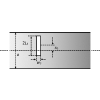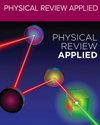Enabling Wide Bandwidth in Substrate-Integrated Waveguide Slot Antennas by Using Low-Index Metamaterials
IF 3.8
2区 物理与天体物理
Q2 PHYSICS, APPLIED
引用次数: 0
Abstract
This paper presents a solution to overcome the inherently limited bandwidth of substrate-integrated waveguide (SIW) slot antennas. It is analytically shown that by decreasing the permittivity of a dielectric loaded slot antenna, the resulting bandwidth increases significantly, where the widest bandwidth can be achieved when the permittivity of the dielectric is less than unity. To demonstrate this concept, a rectangular SIW slot is loaded by an array of thin wires to realize the desired low-index metamaterials (MTMs), which consequently results in a single-layer, compact, and cost-effective structure. We have measured an impedance bandwidth of 36.2%, covering the millimeter-wave (mmWave) frequency range of 19.7–28.4 GHz. The radiation efficiency is above 90%, providing at least 7.5 decibels relative to isotropic (dBi) gain through the entire frequency band, making it a potential candidate for industrial, scientific and medical (ISM) and/or automotive radar ( GHz) and 5G ( GHz). Measurements show that the proposed antenna not only has a broad impedance bandwidth but also an improved radiation bandwidth.

利用低指数超材料实现基底集成波导槽天线的宽带宽
本文提出了一种克服基底集成波导(SIW)槽形天线固有带宽限制的解决方案。分析表明,通过降低介质加载槽形天线的介电常数,可显著增加带宽,当介质的介电常数小于 1 时,可实现最宽的带宽。为了证明这一概念,我们用细线阵列加载矩形 SIW 槽来实现所需的低指数超材料 (MTM),从而获得了一种单层、紧凑且经济高效的结构。我们测得的阻抗带宽(|S11|<-10dB)为 36.2%,覆盖了 19.7-28.4 GHz 的毫米波(mmWave)频率范围。辐射效率超过 90%,在整个频段提供至少 7.5 分贝(dBi)的各向同性增益,使其成为工业、科学和医疗 (ISM) 和/或汽车雷达(24.125--24.25 GHz)和 5G (24.25--28.35 GHz)的潜在候选天线。测量结果表明,拟议的天线不仅具有宽阻抗带宽,而且辐射带宽也有所提高。
本文章由计算机程序翻译,如有差异,请以英文原文为准。
求助全文
约1分钟内获得全文
求助全文
来源期刊

Physical Review Applied
PHYSICS, APPLIED-
CiteScore
7.80
自引率
8.70%
发文量
760
审稿时长
2.5 months
期刊介绍:
Physical Review Applied (PRApplied) publishes high-quality papers that bridge the gap between engineering and physics, and between current and future technologies. PRApplied welcomes papers from both the engineering and physics communities, in academia and industry.
PRApplied focuses on topics including:
Biophysics, bioelectronics, and biomedical engineering,
Device physics,
Electronics,
Technology to harvest, store, and transmit energy, focusing on renewable energy technologies,
Geophysics and space science,
Industrial physics,
Magnetism and spintronics,
Metamaterials,
Microfluidics,
Nonlinear dynamics and pattern formation in natural or manufactured systems,
Nanoscience and nanotechnology,
Optics, optoelectronics, photonics, and photonic devices,
Quantum information processing, both algorithms and hardware,
Soft matter physics, including granular and complex fluids and active matter.
 求助内容:
求助内容: 应助结果提醒方式:
应助结果提醒方式:


